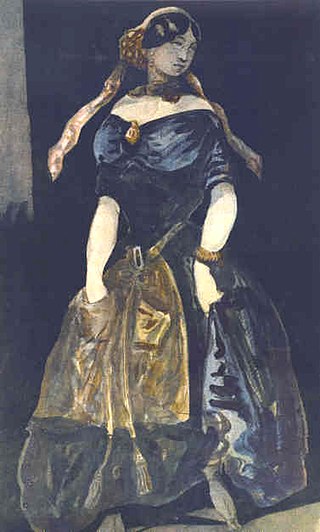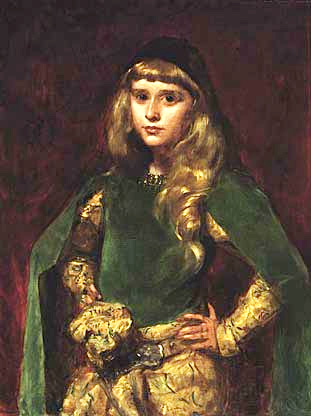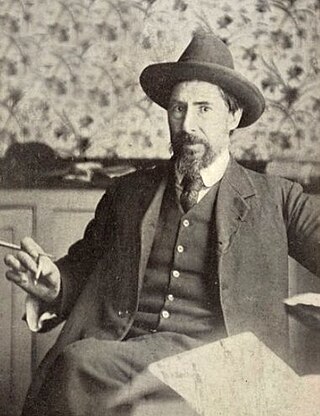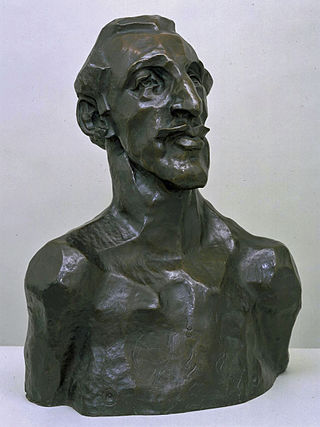
La bohème is an opera in four acts, composed by Giacomo Puccini between 1893 and 1895 to an Italian libretto by Luigi Illica and Giuseppe Giacosa, based on Scènes de la vie de bohème (1851) by Henri Murger. The story is set in Paris around 1830 and shows the Bohemian lifestyle of a poor seamstress and her artist friends.

The Works Progress Administration was an American New Deal agency that employed millions of jobseekers to carry out public works projects, including the construction of public buildings and roads. It was set up on May 6, 1935, by presidential order, as a key part of the Second New Deal.

Bohemianism is a social and cultural movement that has, at its core, a way of life away from society's conventional norms and expectations. The term originates from the French bohème and spread to the English-speaking world. It was used to describe mid-19th-century non-traditional lifestyles, especially of artists, writers, journalists, musicians, and actors in major European cities.

The Federal Theatre Project was a theatre program established during the Great Depression as part of the New Deal to fund live artistic performances and entertainment programs in the United States. It was one of five Federal Project Number One projects sponsored by the Works Progress Administration, created not as a cultural activity but as a relief measure to employ artists, writers, directors, and theater workers. National director Hallie Flanagan shaped the FTP into a federation of regional theaters that created relevant art, encouraged experimentation in new forms and techniques, and made it possible for millions of Americans to see live theatre for the first time. Although The Federal Theatre project consumed only 0.5% of the allocated budget from the WPA and was widely considered a commercial and critical success, the project became a source of heated political contention. Congress responded to the project's racial integration and accusations of Communist infiltration and cancelled its funding effective June 30, 1939. One month before the project's end, drama critic Brooks Atkinson summarized: "Although the Federal Theatre is far from perfect, it has kept an average of ten thousand people employed on work that has helped to lift the dead weight from the lives of millions of Americans. It has been the best friend the theatre as an institution has ever had in this country."

Louis-Henri Murger, also known as Henri Murger and Henry Murger, was a French novelist and poet.

The word grisette has referred to a French working-class woman from the late 17th century and remained in common use through the Belle Époque era, albeit with some modifications to its meaning. It derives from gris and refers to the cheap grey fabric of the dresses these women originally wore. The 1694 edition of the Dictionnaire de l'Académie française described a grisette as simply "a woman of lowly condition". By the 1835 edition of the dictionary, her status had risen somewhat. She was described as:
...a young working woman who is coquettish and flirtatious.

Gaetano (Tony) Gaudio, A.S.C. was a pioneer Italian-American cinematographer of more than 1000 films. Gaudio won the Academy Award for Best Cinematography for Anthony Adverse, becoming the first Italian to have won an Oscar, and was nominated five additional times for Hell's Angels, Juarez, The Letter, Corvette K-225, and A Song to Remember. He is cited as the first to have created a montage sequence for a film in The Mark of Zorro. He was among the founders of the American Society of Cinematographers, and served as President from 1924 until 1925.

Jacob Kramer was a Russian Empire-born painter who spent all of his working life in England.

The Bohemian style, often termed 'Boho chic', is a fashion and lifestyle choice characterized by its unconventional and free-spirited essence. While its precise origins are debated, Bohemian style is believed to have been influenced by the nomadic lifestyle of the Romani people during the late 19th century to the early 20th century. The term 'Bohemian' itself derives from the French 'Bohémien,' originally associated with the Roma community due to a historical misconception that they originated from Bohemia, a region in the Czech Republic.

Experiments in Living is the debut album of Four Day Hombre, and was released on March 13, 2006. It is available on CD only. The title of the album is inspired by the book Among the Bohemians: Experiments in Living 1900-1939, by Virginia Nicholson.

Antoine Chintreuil was a French landscape painter. He was among the starving artists who lived la vie de bohéme in Paris in the 1840s, as popularized by his friend and fellow Bohemian, the novelist Henri Murger. In 1863, he was one of the principal organizers of the Salon des Refusés, which set in motion major reforms in the workings of the annual Paris Salon. He has been called the "great-grandfather of the Impressionists," but Chintreuil himself was never part of a movement, and his paintings, especially the major works from the last decade of his life, remain difficult for critics and art historians to classify. The height of his fame came in the years immediately after his death from tuberculosis in 1873, when his life-partner and fellow artist Jean Desbrosses promoted his legacy with a major book and exhibition in Paris. His reputation later waned, but a large exhibition of his work was mounted in France in 2002, and his works are held in museums across France, with the largest holdings at the Musée d'Orsay.
STEAM fields are the areas of science, technology, engineering, the arts, and mathematics. STEAM is designed to integrate STEM subjects with arts subjects into various relevant education disciplines. These programs aim to teach students innovation, to think critically, and to use engineering or technology in imaginative designs or creative approaches to real-world problems while building on students' mathematics and science base. STEAM programs add arts to STEM curriculum by drawing on reasoning and design principles, and encouraging creative solutions.

Jacqueline Marval was the pseudonym for Marie Josephine Vallet, who was a French painter, lithographer and sculptor.
Tzigane is a novel by the English writer Lady Eleanor Smith, which was first published in 1935. Along with several of her other works it contains a gypsy theme.

Alexander Stewart Gray was a Scottish advocate, artist, and campaigner against unemployment. He led a "hunger march", fasted outside Windsor Castle, and created an artist's colony near Regent's Park.

The Crab Tree Club was a nightclub in Greek Street, Soho, London, that was established by the painter Augustus John in April 1914 with the financial support of Thomas Scott-Ellis. John wrote to his friend John Quinn, "We are starting a new club in town called the 'Crab-tree' for artists, poets and musicians... It ought to be amusing and useful at times". The club was a popular meeting place for London bohemians immediately before the First World War who would descend en-masse on the Crab Tree after the Café Royal closed for the night.

Lilian Shelley was an artists' model, music hall entertainer, and cabaret singer in London in the 1910s and 1920s, known as "The Bug" or "The Pocket Edition". She posed for Jacob Epstein and Augustus John.

Horace Ascher Brodzky was an Australian-born artist and writer most of whose work was created in London and New York. His work included paintings, drawings and linocuts, of which he was an early pioneer. An associate in his early career of many leading artists working in the Britain of his period, including Henri Gaudier-Brzeska, Mark Gertler, and members of the Vorticism movement, he ended his life relatively neglected.
Virginia Nicholson is an English non-fiction author known for her works of women's history in the first half of the twentieth century. Nicholson was born in Newcastle and grew up in Leeds before becoming a television researcher.
Experiments in Living may refer to:

















